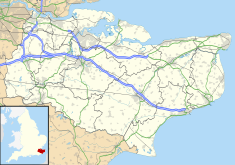| Canterbury Guildhall | |
|---|---|
 Canterbury Guildhall | |
| Location | St Peter's Place, Canterbury |
| Coordinates | 51°16′53″N 1°04′33″E / 51.2813°N 1.0757°E |
| Built | 1381 |
| Architectural style(s) | Gothic style |
Listed Building – Grade II* | |
| Official name | Church of the Holy Cross |
| Designated | 3 December 1949 |
| Reference no. | 1241661 |
Canterbury Guildhall, formerly the Church of the Holy Cross, is a municipal building in St Peter's Place in Canterbury, Kent, England. The structure, which is the meeting place of Canterbury City Council, is a Grade II* listed building.[1]
History
[edit]
The original guildhall in Canterbury was located at the corner of High Street and Guildhall Street and was completed in 1180.[2] The building, which was rebuilt in 1437, 1688 and 1697, was used as a venue for magistrates court hearings and hosted a concert at which the young composer, Wolfgang Amadeus Mozart, performed one of his pieces in 1765.[2]
The building in the High Street was remodelled in the neoclassical style in ashlar stone in 1835.[2] The design involved a symmetrical main frontage with three bays facing onto the High Street; the ground floor featured a rounded headed doorway flanked by two round headed windows. There were sash windows on the first floor flanked by Corinthian order pilasters supporting an entablature and a heavily modillioned pediment with a coat of arms in the tympanum. Internally, the principal room was the main hall, which was decorated with pikes, matchlocks and other weapons seized by Parliamentary Forces from Lady Wootton's house at St Augustine's Abbey, as well as a portrait of Queen Anne by Thomas Gibbs.[3] When Frederick Temple became Archbishop of Canterbury in 1896, he was given an enthusiastic reception by the mayor and the corporation of the city at the guildhall.[4]
The building was primarily used as a venue for civic events after council officers and their departments moved to the Municipal Buildings in Marlowe Avenue.[5][6] The remodelling carried out in the 19th century involved poor construction which led to the flint walls being declared unstable. Despite considerable controversy at the time, with the exception of the undercroft which still survives, the guildhall was demolished in 1950.[2][7]
Meanwhile, the Church of the Holy Cross near the Westgate, had been commissioned by Archbishop Simon Sudbury and completed before his death in 1381.[8][9] The design of the church, which originally formed part of the St Gregory's Priory, involved a nave, a chancel and two aisles, and there was a square tower facing northwest towards the River Stour.[10]
After the church was declared redundant and de-consecrated in 1972, it was acquired by the city council and converted for municipal use: it was officially re-opened by the Prince of Wales as the new Guildhall and meeting place of the city council on 9 November 1978.[11] In May 2021, the city council announced aspirations to secure funding for a scheme which would link the guildhall with other heritage assets in the immediate area such as Westgate and would also involve the council chamber becoming a visitor attraction.[12]
See also
[edit]References
[edit]- ^ Historic England. "Church of the Holy Cross (1241661)". National Heritage List for England. Retrieved 25 June 2021.
- ^ a b c d "The Guildhall Canterbury". Canterbury Archaeology. Retrieved 25 June 2021.
- ^ "The Guildhall". Historic Canterbury. Retrieved 25 June 2021.
- ^ Chandler, Michael (2019). Queen Victoria's Archbishops of Canterbury. Sacristy Press. p. 335. ISBN 978-1789590593.
- ^ Historic England. "Municipal Buildings (1240482)". National Heritage List for England. Retrieved 25 June 2021.
- ^ "No. 34268". The London Gazette. 27 March 1936. p. 1983.
- ^ Historic England. "The Guildhall, Canterbury (1085024)". National Heritage List for England. Retrieved 25 June 2021.
- ^ Bax, Stephen (2000). "Canterbury buildings". Westgate Tower. Archived from the original on 12 July 2011. Retrieved 28 January 2010.
- ^ Historic England. "Church of the Holy Cross, Canterbury (1241661)". National Heritage List for England. Retrieved 8 November 2020.
- ^ "Holy Cross Church". Historic Canterbury. Retrieved 25 June 2021.
- ^ "Remember Prince is Freeman of City". Kentish Gazette. 14 February 2013. Retrieved 25 June 2021.
- ^ "Bold vision to 'reinvent' Canterbury into city with worldwide appeal revealed by council". 27 May 2021. Retrieved 25 June 2021.









